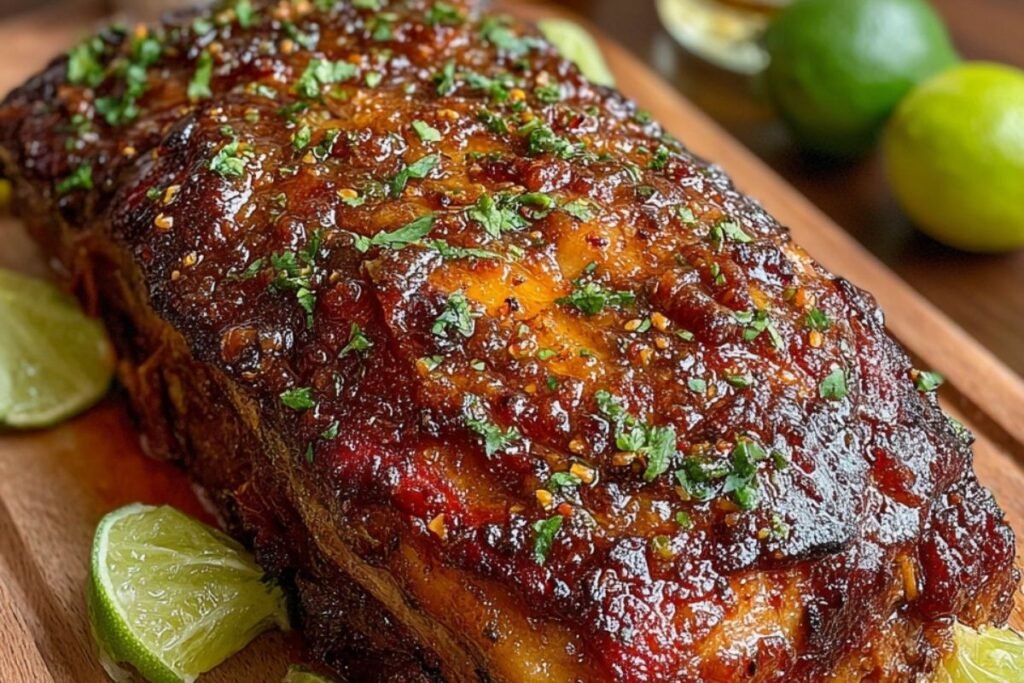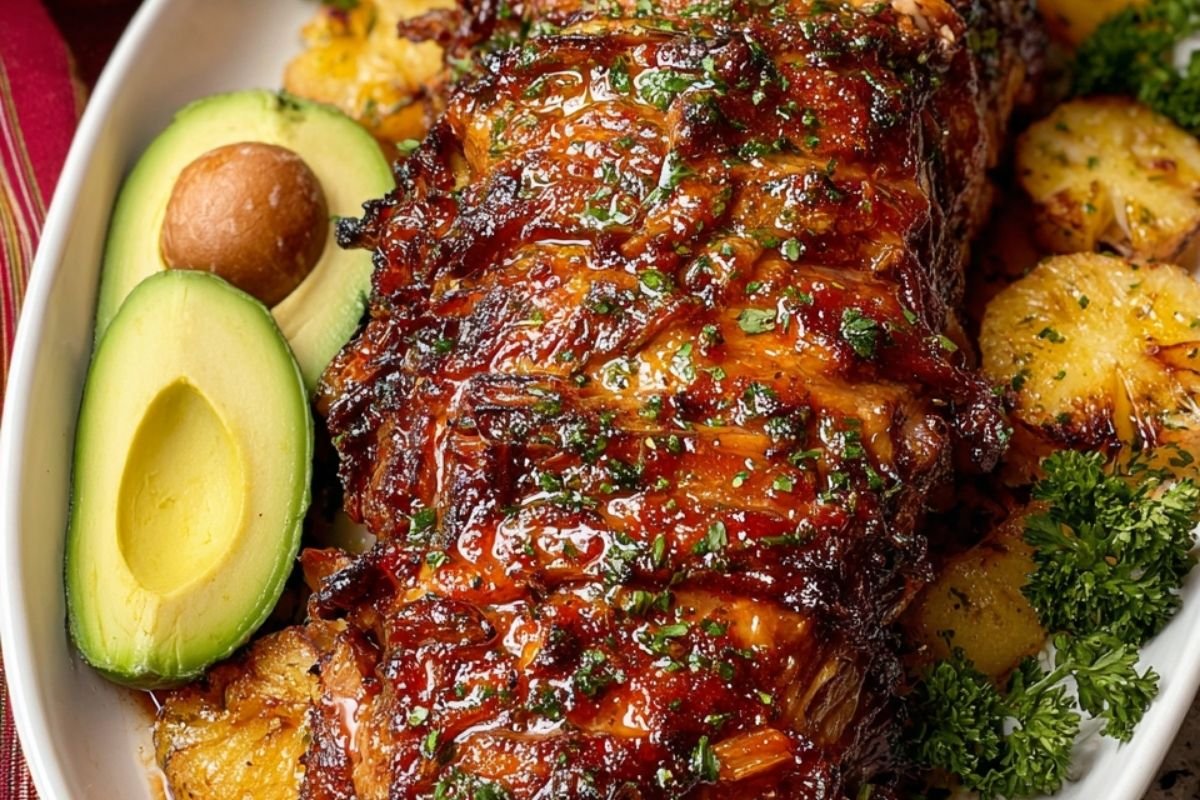Introduction
Few dishes represent Puerto Rican holiday cooking like pernil. This mouthwatering bone-in roast pork shoulder, marinated in a potent blend of garlic, oregano, citrus, adobo, and olive oil, is slow-roasted until the meat is fall-apart tender and the skin is perfectly crispy (known as “cuerito”). It’s a meal that brings families together and fills kitchens with the rich aroma of tradition and celebration.
Puerto Rican pernil (bone-in roast pork) is most popular during the holidays—especially Nochebuena (Christmas Eve)—but it’s too good to save for just once a year. Whether it’s for a Sunday dinner, a birthday party, or simply to share leftovers for days, pernil is a celebration in itself.
In this guide, you’ll get an authentic recipe with step-by-step instructions, expert tips for achieving that perfect crackling skin, and ideas for side dishes, variations, and serving. We’ll also dig into its cultural significance and answer your most common questions so you can bring a bit of Puerto Rican soul food to your table, no matter where you are.
What is Pernil?
Pernil is a Puerto Rican slow-roasted pork shoulder, traditionally seasoned with a marinade called “mojo” or a sofrito blend—consisting of garlic, herbs, spices, and sometimes citrus juice. It’s roasted bone-in for maximum flavor and to keep the meat juicy.
The highlight of a good pernil? The crispy, crackling skin on top, known as cuerito. This crunchy layer contrasts with the juicy interior, creating a texture experience that defines great pernil.
While it’s enjoyed year-round in Puerto Rico, it’s a centerpiece for holidays, birthdays, and big family gatherings.
Why You’ll Love Puerto Rican Pernil
- Incredible Flavor: Garlic, oregano, citrus, and adobo create an unforgettable taste.
- Texture Perfection: Tender pork + crispy skin = flavor and crunch in every bite.
- Great for Gatherings: A single roast feeds a crowd—and leftovers are even better.
- Meal Prep Magic: Make it ahead and reheat. It gets better with time.
- Culturally Rich: Connects you to Caribbean tradition and family heritage.
Ingredients
Here’s what you’ll need for a classic Puerto Rican pernil. All measurements are for a 7–9 lb bone-in pork shoulder.

- 1 bone-in pork shoulder (7–9 lbs)
- 10 garlic cloves (or 1 full head)
- 1 tablespoon salt
- 2 teaspoons black pepper
- 1 tablespoon dried oregano
- 1 tablespoon ground cumin
- 1 tablespoon smoked paprika
- 2 teaspoons onion powder
- ½ cup olive oil
- ⅓ cup orange juice (fresh preferred)
- ¼ cup lime juice
- 2 tablespoons apple cider vinegar
- 1 tablespoon adobo seasoning
- 1 packet of sazón (optional, for color)
Equipment Needed
- Roasting pan with rack
- Sharp paring knife
- Mortar and pestle or food processor (for garlic paste)
- Aluminum foil
- Meat thermometer
- Paper towels
Step-by-Step Recipe
Step 1: Prep the Pork
- Rinse the pork shoulder and pat it dry completely with paper towels.
- Using a sharp paring knife, score the fat and skin in a criss-cross pattern without cutting into the meat.
- If desired, separate the skin slightly from the meat to allow marinade underneath—but keep it attached.
Step 2: Make the Marinade
In a mortar and pestle or food processor, combine:
- Garlic cloves
- Salt
- Pepper
- Oregano
- Cumin
- Paprika
- Onion powder
- Olive oil
- Orange juice
- Lime juice
- Vinegar
- Adobo
- Sazón (if using)
Mash or blend into a thick, aromatic paste.
Step 3: Season the Pernil
- Rub the marinade all over the pork—top, bottom, and especially deep into the slits and under the skin.
- Wrap the roast tightly in plastic wrap or foil.
- Marinate overnight, or for at least 8 hours in the refrigerator.
Step 4: Roast Low and Slow
- Preheat your oven to 300°F (150°C).
- Unwrap the pork and place it in a roasting pan, skin side up.
- Tent loosely with foil.
- Roast for 4½ to 5 hours, or until meat pulls away easily with a fork.
Step 5: Crisp the Skin
- Increase oven temperature to 450°F (230°C).
- Remove foil and roast for another 30–45 minutes, or until the skin is bubbly and crisp.
- Watch carefully to avoid burning.
Step 6: Rest and Serve
- Let the pernil rest for 20–30 minutes before slicing or shredding.
- Serve with rice, beans, tostones, or mofongo.
Pro Tips for Perfect Pernil
- Marinate long: The longer the marination, the deeper the flavor. Overnight is best.
- Dry the skin well: For crispiness, make sure the skin is dry before roasting.
- Slow roast: Low heat breaks down collagen, making the pork ultra-tender.
- Broil with care: Keep an eye on the final roast to avoid burning the skin.
- Use a meat thermometer: Aim for internal temp around 195–205°F for pull-apart perfection.
Serving Suggestions
Traditional Pairings:
- Arroz con gandules (rice with pigeon peas)
- Tostones (fried green plantains)
- Maduros (sweet fried plantains)
- Puerto Rican potato salad
- Avocado slices
- Pickled red onions
Drinks:
- Sparkling cider
- Passion fruit juice
- Tamarind drink
- Coquito (non-alcoholic coconut milk version)
Nutrition (Per Serving, approx. 6 oz)
- Calories: 420 kcal
- Protein: 36g
- Fat: 30g
- Carbohydrates: 1g
- Fiber: 0g
- Sugar: 0g
- Gluten-Free: Yes
Flavor Variations
- Garlic Mojo Only: Skip citrus and go full garlic-oregano mojo.
- Spicy Pernil: Add crushed red pepper or hot sauce to the marinade.
- Herb-Heavy: Blend fresh cilantro or parsley for a green herb marinade.
- No Skin? Use a boneless pork shoulder for quicker cooking—just know you’ll miss the cuerito!
Make-Ahead and Leftovers
Make-Ahead:
- Marinate up to 2 days in advance.
- Roast a day ahead and reheat in a 300°F oven, covered with foil.
Leftovers:
- Shred for tacos, sandwiches, quesadillas.
- Use in fried rice or add to soup.
- Freeze in portions for up to 3 months.
FAQs
Q: Can I make pernil without the skin?
Yes! You’ll still get juicy, flavorful pork. But you’ll miss out on the crispy cuerito.
Q: Can I use boneless pork shoulder?
Absolutely. It will cook slightly faster but still be delicious.
Q: How do I make pernil crispy on top?
Dry the skin well, cook uncovered at the end, and broil if necessary for extra crunch.
Q: Is pernil spicy?
No, it’s garlicky and savory. You can add spice if desired.
Q: Can I make it in a slow cooker?
Yes—marinate as usual, cook on low for 8–10 hours, then transfer to oven or broiler to crisp.
Q: What does “pernil” mean?
It comes from the Spanish word “pierna” (leg), though pernil typically uses shoulder, not leg.
Conclusion
Puerto Rican Pernil (Bone-In Roast Pork) is more than a meal—it’s a cultural ritual, a holiday symbol, and a dish that brings generations together around the table. With a crisp, golden skin and deeply seasoned, juicy meat, pernil earns its place as the centerpiece of any festive spread.
Even if you’re new to Puerto Rican cooking, this recipe is completely approachable and rewarding. The flavors are bold but balanced, and the process—while slow—is simple and straightforward. From the marinade to the carving board, pernil delivers comfort, nostalgia, and incredible taste.
Bring it to your table this season, and let this Puerto Rican classic become a tradition in your home.
Print
Puerto Rican Pernil (Bone-In Roast Pork) – Authentic, Flavor-Packed Holiday Centerpiece with Garlic, Citrus, and Crispy Skin
Ingredients
-
1 bone-in pork shoulder (7–9 lbs)
-
10 garlic cloves (or 1 full head)
-
1 tablespoon salt
-
2 teaspoons black pepper
-
1 tablespoon dried oregano
-
1 tablespoon ground cumin
-
1 tablespoon smoked paprika
-
2 teaspoons onion powder
-
½ cup olive oil
-
⅓ cup orange juice (fresh preferred)
-
¼ cup lime juice
-
2 tablespoons apple cider vinegar
-
1 tablespoon adobo seasoning
-
1 packet of sazón (optional, for color)
Instructions
Step 1: Prep the Pork
-
Rinse the pork shoulder and pat it dry completely with paper towels.
-
Using a sharp paring knife, score the fat and skin in a criss-cross pattern without cutting into the meat.
-
If desired, separate the skin slightly from the meat to allow marinade underneath—but keep it attached.
Step 2: Make the Marinade
In a mortar and pestle or food processor, combine:
-
Garlic cloves
-
Salt
-
Pepper
-
Oregano
-
Cumin
-
Paprika
-
Onion powder
-
Olive oil
-
Orange juice
-
Lime juice
-
Vinegar
-
Adobo
-
Sazón (if using)
Mash or blend into a thick, aromatic paste.
Step 3: Season the Pernil
-
Rub the marinade all over the pork—top, bottom, and especially deep into the slits and under the skin.
-
Wrap the roast tightly in plastic wrap or foil.
-
Marinate overnight, or for at least 8 hours in the refrigerator.
Step 4: Roast Low and Slow
-
Preheat your oven to 300°F (150°C).
-
Unwrap the pork and place it in a roasting pan, skin side up.
-
Tent loosely with foil.
-
Roast for 4½ to 5 hours, or until meat pulls away easily with a fork.
Step 5: Crisp the Skin
-
Increase oven temperature to 450°F (230°C).
-
Remove foil and roast for another 30–45 minutes, or until the skin is bubbly and crisp.
-
Watch carefully to avoid burning.
Step 6: Rest and Serve
-
Let the pernil rest for 20–30 minutes before slicing or shredding.
-
Serve with rice, beans, tostones, or mofongo.
